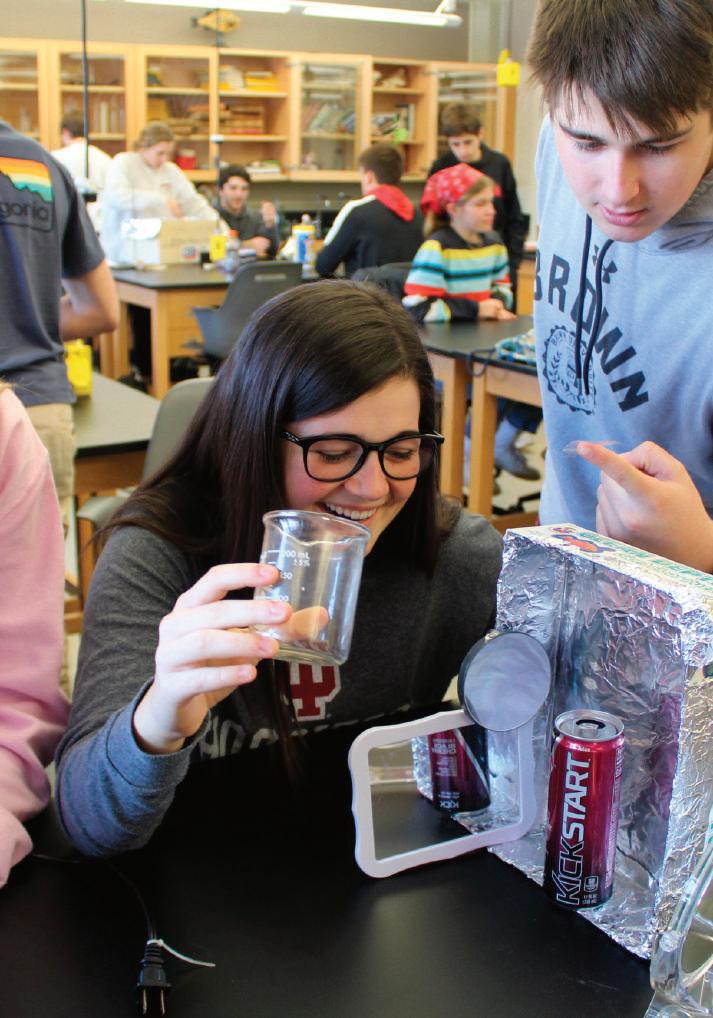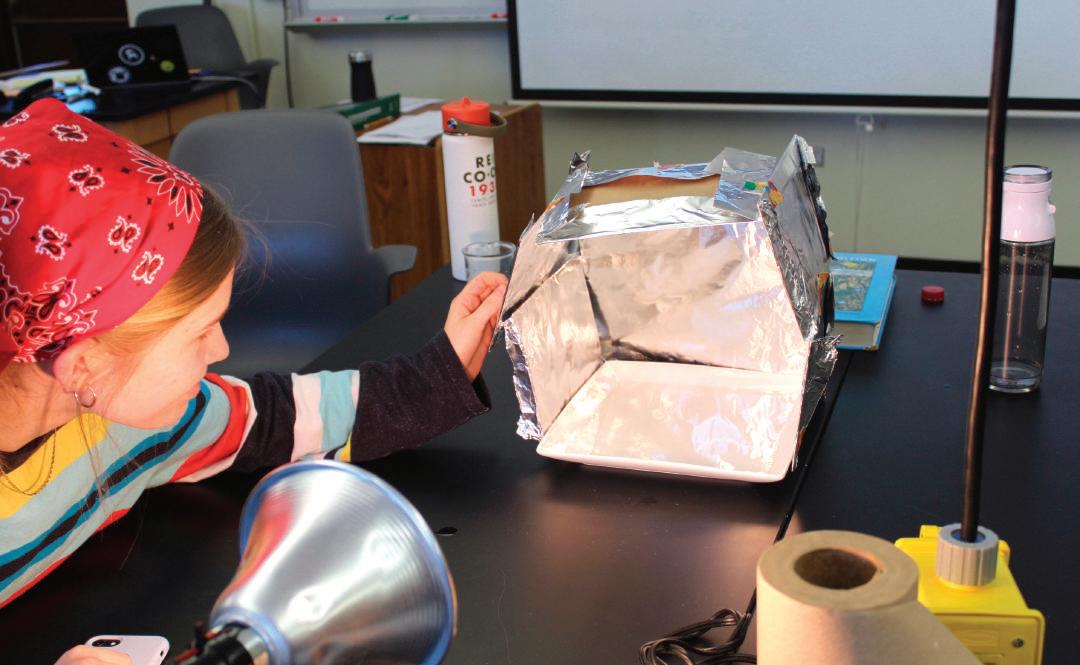
9 minute read
IT’S THE 5 YEAR
It’s the Five Year
Countdown
Advertisement
by John Olsen & Dalya Laban design by Loukas Bezanis
D86 works on Year 1 in a 5 year plan to improve and align Central and South, starting with science curriculum equity.
Photo by Sofija Buzelis Seniors Jessica Joy and Scott Pitts experiment during AP Environmental Science.
After the School Board approved the recommended changes to the science sequencing at Central in October 2019, an immense amount of feedback from the community followed. Parents expressed their opinions and views through a variety of outlets, including Facebook groups, online petitions, and emailing Board and Administration members directly. Many students at Central also posted links to a petition opposing these changes on social media, while others expressed their support for the changes. “The lack of transparency and suddenness of this overhaul has poor optics and should be reconsidered,” a user on the Change.org petition wrote. “Please slow down the changes to the HC and HS science programs.” Despite the pushback from some parents and students, District 86 will continue to follow these changes, and plans to apply them for the 2021-2022 school year. Julie May, Science Department Chair at Central, said that the new science sequence at Central will bring hopes for the future of students’ college education as well as their jobs. “I’m hoping that [students] walk out of here with a real appreciation for science, maybe even more than what they had before,” May said. However, the changes to the science sequencing are only a small part of a much larger plan to improve the learning
environment for students at both Central and South. This plan, named the “Strategic Plan” by the District, was approved by the Board on May 21, 2018, and aims to align curriculums at Central and South, along with many other goals before the 2024-25 school year. As stated on the D86 website, this plan is designed to “empower students to pursue their ideal futures by acquiring critical skills and knowledge to collaborate, create, and connect with an ever-changing world.” The Strategic Plan consists of five goals with multiple strategies within each goal. These five goals are based around student growth and achievement, the learning environment, the work environment, family and community connections, and resources. Each goal has a defined statement that communicates what the District is looking to improve. Tammy Prentiss, Superintendent, said that the Strategic Plan creates a positive working environment. “It’s very helpful to have boundaries so that you can focus and get that work done,” Prentiss said. For example, Goal 2, the Learning Environment, has a statement that says, “The learning environment promotes student well being.” Every goal also has a Goal Champion who oversees the overall progress of achieving the goal Photo by Sofija Buzelis
Senior Chloe Lannert applies her AP Environmental Science curriculum to a project.

and reports back to the Superintendent. Goal 2’s Champion is Brad Verthein, who is an Assistant Superintendent. Beneath the Goal Champion are strategy leaders, who oversee the individual strategies laid out within the goal, and beneath them are the members within each strategy. According to Prentiss, of the five goals, number one, which concerns Student Growth and Achievement has had the most work done on it in terms of time spent, most notably with the new science sequencing at Central. Currently, Central has a very open sequence that gives students a multitude of options starting their freshman year. Incoming freshmen could take Earth Science, Biology, or Chemistry, and would have more options after that in their sophomore year. Jackson Hughes, senior, is a student liaison to the School Board, which means that he gives a report to the Board once a month on various aspects of student life at Central, said he supports the idea of an open curriculum. “[The current curriculum] allows students at Hinsdale Central to form their own path. It allowed me to make my own path and explore my interests,” Hughes said. Hughes took Chemistry Honors his freshman year, which prompted him to take AP Chemistry his sophomore year along with AP Physics 1, which then led him to taking AP Physics C his junior year. He credits the freedom of this sequence for developing his interest in science. The District is now adapting Central’s science sequence to a Physics freshman year, Chemistry sophomore year, Biology junior year track that also has incorporated Earth Science into each of these classes. This change was made and approved in accordance with Strategy 1 in Goal 1, which includes aligned curriculums between Central and South. In order to determine what science sequence the two schools would be aligned with, the District formed a committee composed of teachers, department heads, principals, and assistant principals from both schools, along with an assistant superintendent. This committee looked at nine different sequences that included both Central and South’s current sequences along with many other options and evaluated them based on six different goals that aligned with the Strategic plan. These included: aligning courses, increasing student exposure to and interest in core sciences, aligning courses with college and career opportunities, creating a strategic and coherent science program, providing informed student choice in coursework junior and senior year, and increasing Social/
”Emotional Learning (SEL) considerations for students and parents. From these goals, the committee determined that a Physics-Chemistry-Biology sequence that builds on itself and incorporates Earth Science concepts and follows the Next Generation Science Standards (NGSS) would benefit students the most. “The best phrase I have heard to describe the new science standards is that our secondary students need to be doing science, not sitting and getting science,” Prentiss said. May said she also believes in this idea, “Our goal as people who are creating these courses is for them to be hands on classes. They’re really teaching students to think about science, the process of science, how you do science, as well as learning physics and chemistry and biology and earth science along the way.” In this new sequence, freshmen will have the option between Physics and Physics Honors, in their sophomore year they can choose between Chemistry and Chemistry Honors, and their junior year they can take either Biology or AP Biology. Students will also have the option to double up on science starting their sophomore year with a select few AP courses, with the rest of the courses becoming available junior year. The limited availability of AP courses to sophomores in this new sequencing worries Hughes, as he had a very positive experience with AP science classes his sophomore year. “This is something that was a concern to me because I did take those AP classes so early on, which I think helped springboard myself into my interest in science,” Hughes said. “And I have plenty of friends who have had the same experience.” This new sequencing will be available to freshmen enrolling this fall, although they will have the option to follow the current sequence at Central as well. Starting in the 2021-22 school year, all incoming freshmen will be following the new sequence. Current students at Central will follow the current sequence until they graduate. AP Physics I, AP Physics II, Earth Science Honors, and Biology Honors are no longer offered in the new science sequence, and Anatomy and Physiology has been added as a new course to Central’s curriculum. In addition to the aforementioned AP and Honors classes that are no longer being offered, the District is eliminating G-level science classes, which are classes that assist students with reading comprehension regarding science, putting these students on the regular track. To accommodate these students, the science department is implementing interventionists. Interventionists would be science teachers who are free various periods of the day and can go into classrooms and help students who might be struggling or to provide them assistance outside of the classroom. May said she believes that having interventionists is a much more efficient method than isolating students in their own G-level class. “[An interventionist] might be able to work with a group of kids to help bring them up to where they need to be rather than having them in a classroom by themselves,” May said. “There’s also a lot of students in our general level program capable of being in a regular level class.” Prentiss said she does not support the idea of secondary tracking, such as general level classes in science. “Does [secondary tracking] help the students? Does it close the gap? The answer is no,” Prentiss said. “There is no support for remedial and secondary tracking.” Overall, there is much optimism from May about what this new science sequencing will bring for incoming students, regardless of how split the opinion from the community on it is. “I have heard parents who are super excited about this program and I have spoken to a number of parents of incoming freshmen who are super excited that Strategic Plan, and there are many other goals that need to be tackled and implemented. Prentiss has repurposed the flex learning days this school year so that all teachers from Central and South are talking and working to create uniform grading scales across departments, which is another part of Strategy 1, in Goal 1. “When I took over as Superintendent, there were 38 different grading scales,” Prentiss said. “It’s outrageous. I think science has 23 alone in its department. [I’m letting] the teachers have their voice and [having] them figure out [a uniform grading scale].” The Math department is also beginning to align their curriculums, forming a committee similar to what science did, and following a process similar to that. Prentiss emphasized the importance of feedback from students, staff, and parents, and as part of Goal 3, Family and Community Connections, wants to gain better and more accurate feedback from the community. “The feedback from parents on the 5Essentials survey is currently at 26 percent,” Prentiss said. “They started in October. We remind them all the time. We are trying to find more regular times than just the 5Essentials survey to find ways for our students, stakeholders, and parents to give us feedback, because we’re only hearing from not even a third of our population.” In May’s eyes, everyone in the community, and everyone contributing to this is an option for their kids,” May said. “And then there are parents who are super apprehensive about it. There is a wide range of people and opinions. I think that for the students in this district, this should be a very positive move.” As successful or unsuccessful as these changes to the science sequencing may turn out to be, they are only one small part of the the Strategic Plan is trying to move in the right direction, and create positive change. “There are passionate conversations that are [taking place] because they all want what’s best for the students,” May said. “What I will say is that there may be passionate conversations, but they’re all positive because everyone in their heart is trying to do the right thing.”







